Cooking Fats and Oils
See also: Calorie Counting and Food LabellingOur page on What is Fat? explains that fats (which includes oils) may contain saturated, polyunsaturated and monounsaturated fatty acids. That page also explains what we mean by these terms, which relates to the carbon chemistry of the fatty acids within the fat. Each fat has different proportions of these three types.
The level of saturation affects the properties of the fat, such as its melting point, and when it starts to burn in cooking (known as the smoke point). The proportions of different types of fatty acids may also affect the impact of the fat on our health. However, it is definitely not as simple as “unsaturated good, saturated bad”.
This page explains more about what happens when you use fats for cooking—and why this means that some fats are more suitable for some purposes than others. It also provides information about some of the most commonly used cooking oils and fats, including their proportions of different types of fatty acids and their smoke points.
Cooking with Fats: Factors to Consider
There are three important factors that affect oils when cooking: temperature, moisture and air.
These factors can all change the structure of the oil, and in turn affect its properties—and therefore its effect on health as well as its taste.
What this means in practice is that for cooking, you need to consider what temperature you are cooking at, how long you are cooking for, and whether you reuse the oil. The evidence suggests that you should:
Choose an oil with a relatively high smoke point
The smoke point of an oil or fat is the temperature at which it starts to burn and degrade. Oils and fats with a higher smoke point are more suited to frying food than those with lower smoke points, which are more suited for cold use, such as in salad dressings.
Avoid heating your oil above about 170°C (340°F)
When you heat oils, you change their structure, and you can therefore lose some of their beneficial properties. Extra virgin olive oil is a classic case of this: it contains a lot of polyphenols, which have antioxidant effects, but has a low smoke point so is more sensitive to heat. Frying something like an egg in a home kitchen, you are likely to be heating the oil to around 160 or 170°C.
Avoid repeated use of the same oil, for example in a deep fat fryer.
When oils are reused, in deep frying for example, they degrade. The taste changes, and the products of burning can build up. This is why commercial kitchens are expected to change the oil in their fryers regularly.
Finding out more
To find out more about the science behind using different fats and oils for cooking, you may find it helpful to listen to an episode of the ZOE Science and Nutrition podcast on this subject. A transcript is available here.
You can also find out more about fat as part of our diets from our page What is Fat? or another episode of the ZOE Science and Nutrition podcast available here.
The proportions of different types of fatty acid and smoke points vary for the same type of oil depending on how it has been processed and/or produced. How oil is stored and used also affects its qualities. When not in use, most oils should be kept cool, in airtight containers and out of direct sunlight for maximum longevity.
For these reasons the figures on this page are for general guidance and only apply to fresh, high-quality oils. Check the label or contact the manufacturer of specific oil or fat products for more precise data.
Common Cooking Oils and Fats - Type of Fat Content (Approx. %)
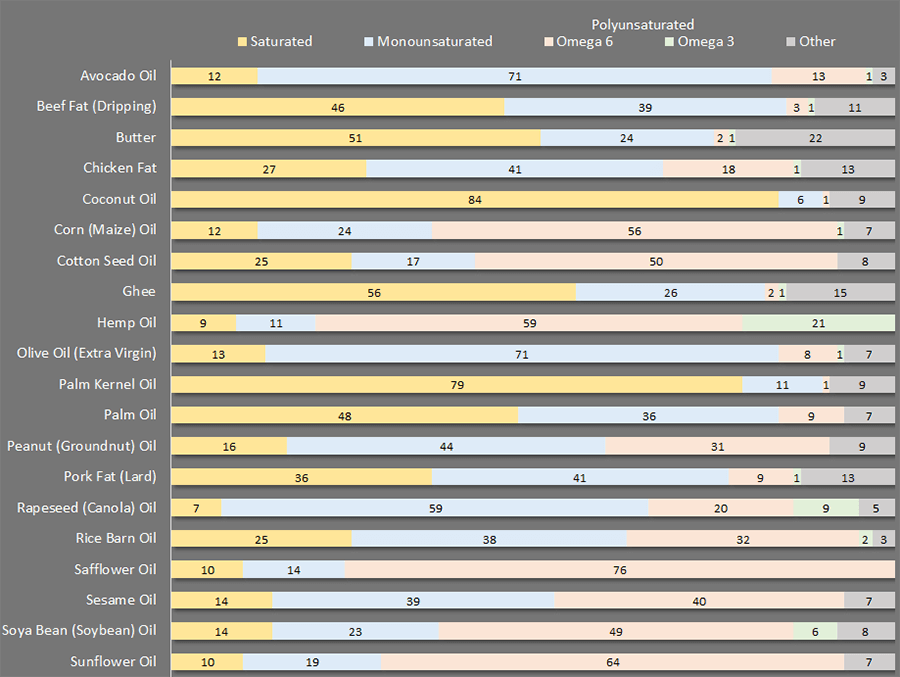
Common Fats and Oils for Cooking
Oils that are commonly used for cooking because of their high smoke point include rapeseed (canola) oil and sunflower oil. Many people also use extra virgin olive oil because of the perceived health benefits, despite its lower smoke point.
The list below contains details of some of the common fats and oils used in cooking.
Alphabetical list of common fats and oils
The following list shows more information about several cooking fats and oils.
Each pie chart displays the percentage value of each type of fat, expanding the polyunsaturated fats to show the proportions of omega-6 and omega-3 fatty acids. Most oils and fats contain other nutrients as well. For example, butter contains proteins as well as fats, and these are included in the ‘other’ segment of the pie charts.
Avocado Oil | |
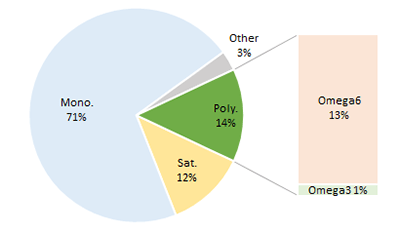 |
Smoke Point: 250oC | 482oF Predominant Fat Type: Monounsaturated |
|
Avocado oil has a similar profile to extra virgin olive oil, but with a slightly higher smoke point. It can therefore be used for all kinds of cooking. However, it is hugely expensive, and at least one study found that the majority of avocado oil sold in the United States was either rancid before its expiry date, or had been adulterated with other oils. Some bottles were almost entirely soybean oil. It may therefore not be worth the high price tag, and experts have suggested that you are better off simply using rapeseed oil. | |
Beef Fat (Dripping) | |
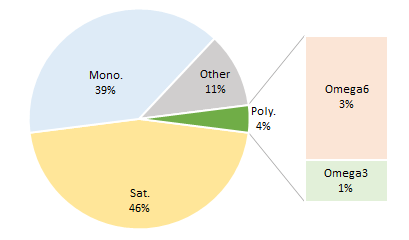 |
Smoke Point: 275oC | 540oF Predominant Fat Type: Saturated |
|
Like lard (pork fat), beef fat was once common in British cuisine, but now has been largely replaced by vegetable oils. Beef fat is still sometimes used for frying fish and chips, making Yorkshire puddings and beef gravy. ‘Dripping’, the solidified fat left over from roasting beef, was traditionally spread on bread as a substitute for butter or margarine, often with added salt. Beef fat has a very high smoke point. | |
Butter |
|
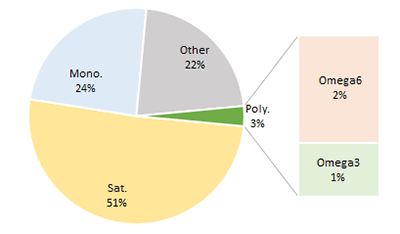 |
Smoke Point: 175oC | 350oF Predominant Fat Type: Saturated |
|
Butter is used widely in cooking, for frying, baking and as a spread. It is therefore considered a staple food in many countries. Butter is most commonly made from cow’s milk, although can be produced from the milk of other mammals, like goats and buffalo. It is therefore not suitable for vegan diets. | |
Butter vs. margarine
Many people substitute margarine for butter believing it to be more healthy.
However, this may not be the case.
It is often better to use butter because it is much less processed, and you know more about what it contains. Butter is certainly fine for most people to eat regularly.
However, research from the ZOE nutrition study suggests that around one-third of people should avoid butter. For these people, can lead to long periods of high blood fat, which is not good for health. However, the ZOE scientists suggest that you should NOT use margarine instead. They suggest using extra virgin olive oil in cooking, and eating cheese in sandwiches or on bread.
Chicken Fat |
|
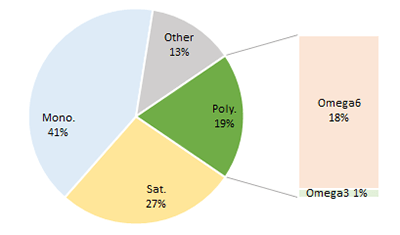 |
Smoke Point: 205oC | 400oF Predominant Fat Type: Monounsaturated |
|
Despite being an animal fat, chicken fat contains more monounsaturated fats than saturated. Chicken fat is used for its flavour to make chicken stock, which in turn is used in soups, sauces and gravies. Chicken fat can be a rich source of omega fatty acids, especially omega-6. As an animal fat, it is not suitable for vegetarian or vegan diets. | |
Coconut Oil |
|
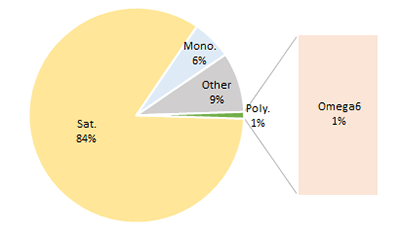 |
Smoke Point: 175oC | 350oF Predominant Fat Type: Saturated |
|
Extracted from the flesh of the coconut, the seed of the coconut palm tree, coconut oil is very high in saturated fat (92%). There is some suggestion that it has health benefits when it is eaten as part of the coconut. However, there is much less evidence of any benefits when it is extracted and used as a cooking oil. It also has a very low smoke point, so is easily oxidised. Coconut oil is often used in curries and other dishes from The Caribbean and Southern Asia, especially in Thai food. |
|
Corn (Maize) Oil |
|
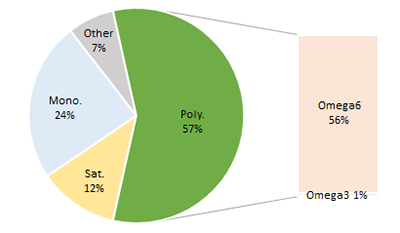 |
Smoke Point: 230oC | 450oF Predominant Fat Type: Polyunsaturated |
|
Corn oil is relatively low in saturated fats and a good source of omega-3, 6 and 9 fatty acids. It is therefore a popular choice for cooking. Corn oil also tends to be inexpensive and has a high burn or smoke point. It is therefore commonly used for fried food, especially deep-fat frying. | |
Cotton Seed Oil |
|
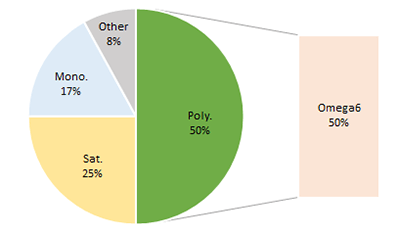 |
Smoke Point: 220oC | 420oF Predominant Fat Type: Polyunsaturated |
|
Cotton seed oil is common in many foodstuffs from salad dressings and mayonnaise to many processed foods, especially in the US, where it is an inexpensive alternative to other oils. Most famously, cotton seed oil is traditionally the main component of Crisco vegetable shortening. | |
Ghee |
|
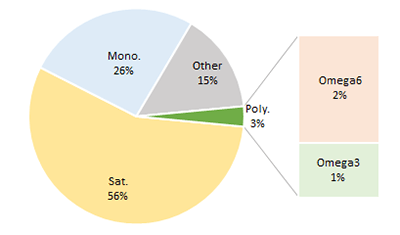 |
Smoke Point: 250oC | 480oF Predominant Fat Type: Saturated |
|
Ghee is a type of clarified butter commonly used in, and associated with, the cuisine of the Indian sub-continent. The quality of ghee can vary considerably depending on the type of butter used and the production method. Unlike butter, ghee does not need to be refrigerated and has a long shelf-life when kept in an air-tight container. | |
Hemp Oil |
|
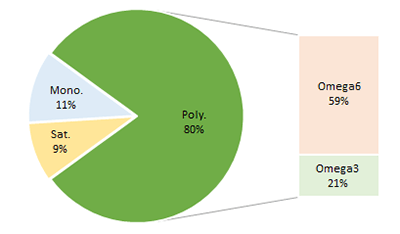 |
Smoke Point: 165oC | 330oF Predominant Fat Type: Polyunsaturated |
|
Hemp oil has a low smoke point, and is therefore not really suited for frying food. However, it has a pleasant nutty taste, and is often used in salad dressings. Quality hemp oil is extracted from hemp seeds by cold pressing, meaning crushing the seeds at an ambient temperature. Heavily processed hemp oil loses a lot of its natural flavour and beneficial qualities. | |
Olive Oil (Extra Virgin) |
|
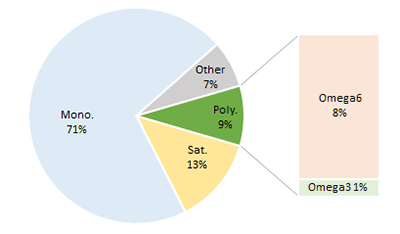 |
Smoke Point: 160oC | 320oF Predominant Fat Type: Monounsaturated |
|
Olive oil is generally considered to be a healthier alternative to many other types of cooking oils and fats. However, the beneficial qualities are only found in ‘extra virgin’ olive oil: the oil from the first pressing of the olives. Blended and processed olive oils do not have the same benefits, and you are better off buying sunflower or vegetable oils. Extra virgin olive oil has a low smoke point and many people therefore suggest that you should not use it for frying food. However, it is quite feasible to use it, provided you are careful with the heat and timing. | |
Palm Kernel Oil |
|
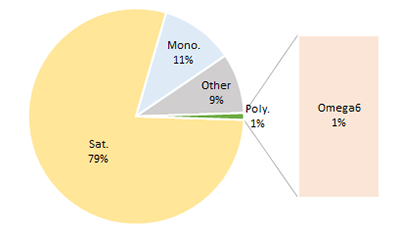 |
Smoke Point: 330oC | 450oF Predominant Fat Type: Saturated |
|
Palm kernel oil is extracted from the kernel of the oil palm tree. It shares similar qualities with, but is not the same as, palm oil, which is extracted from the oil palm fruit. Palm kernel oil is high in saturated fat. Its low price and high smoke point mean it is frequently used in fast food and other commercial cooking. However, there are serious environmental and economic concerns about the farming of the oil palm tree, and particularly the effect on tropical forests and other habitats in Southeast Asia. | |
Palm Oil |
|
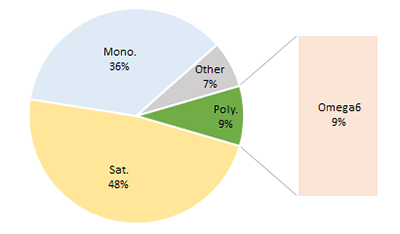 |
Smoke Point: 225oC | 440oF Predominant Fat Type: Saturated |
|
Palm oil is commonly used in tropical countries for cooking, especially in Africa, Southeast Asia and parts of South America. Naturally, palm oil is a rich red colour because it contains high levels of beta-carotene, although it is often processed to remove a lot of the colour. Palm oil is found in a lot of processed foods because it is cheap and extremely functional as an oil. However, recently environmentalists have been suggesting that we should try to avoid its use because of the impact of farming practices on tropical forest habitats in Southeast Asia. | |
Peanut (Groundnut) Oil |
|
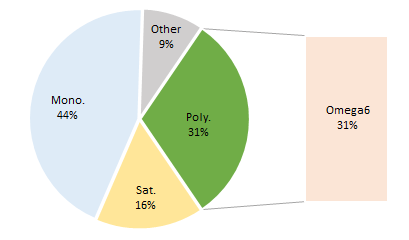 |
Smoke Point: 225oC | 440oF Predominant Fat Type: Monounsaturated |
|
Groundnut oil is commonly used in Chinese cookery, and is derived from refining peanuts. Usually, in the West, commercially available peanut oil has been through a rigorous refining process, which removes allergens from the oil. This means that it is usually safe for people with peanut allergies to use. However cold-pressed peanut oil, a less refined alternative, can be potentially dangerous to peanut allergy sufferers. | |
Pork Fat (Lard) |
|
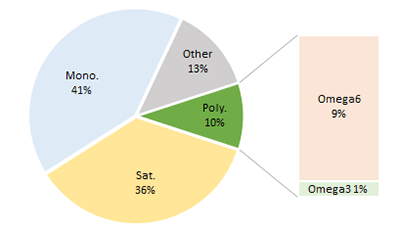 |
Smoke Point: 190oC | 375oF Predominant Fat Type: Monounsaturated |
|
Pork fat, commonly known as lard, was traditionally used as a cooking fat or alternative to butter in a similar way to beef fat or dripping. Lard is less frequently used today as vegetable oils are usually preferred. However, lard is still used in parts of Europe and favoured by some cooks because of its flavour. It is more likely to be used in baking, especially for pastry, than as a fat for frying. As an animal fat, lard is not suitable for vegetarian or vegan diets. | |
Rapeseed (Canola) Oil |
|
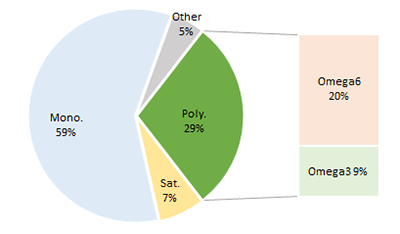 |
Smoke Point: 205oC | 400oF Predominant Fat Type: Monounsaturated |
|
Oilseed rape is a member of the brassica family of plants, which also includes cabbage, broccoli, turnips and mustard. The word ‘rape’ is derived from the Latin for turnip. In the UK, rapeseed oil has become very trendy over recent years, with increasingly large parts of the countryside taken up with growing oilseed rape. Rapeseed oil is often a key ingredient of the generically termed ‘vegetable oil’ in the UK because of its unfortunate name. In North America the oil is usually referred to as ‘canola’, the name deriving from a cultivar of the rapeseed plant. | |
Rice Bran Oil |
|
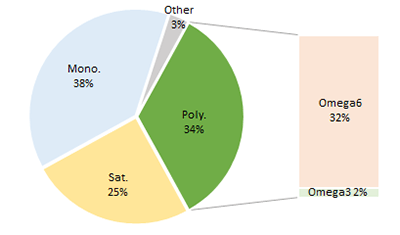 |
Smoke Point: 255oC | 490oF Predominant Fat Type: Monounsaturated |
|
Rice bran oil is extracted from the husk of rice, and is commonly used in Asian cookery, especially in Chinese and Japanese dishes. Rice bran oil is rich in complex compounds with a good balance of types of fats. The oil has a high smoke point and is often used for deep fat frying and stir frying. | |
Safflower Oil |
|
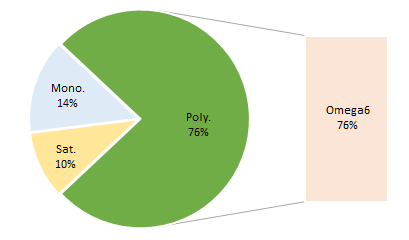 |
Smoke Point: 230oC | 450oF Predominant Fat Type: Polyunsaturated |
|
Safflower oil comes from the seeds of the safflower plant, which resembles a thistle with a yellow flower. There are two main types of safflower oil, one that contains mainly monounsaturated fat and one that contains mainly polyunsaturated. The polyunsaturated version is most commonly used for cooking. Despite its long history, dating back at least as far as the ancient Egyptians, the plant and oil are not common although there has been renewed interest in recent years. | |
Sesame Oil |
|
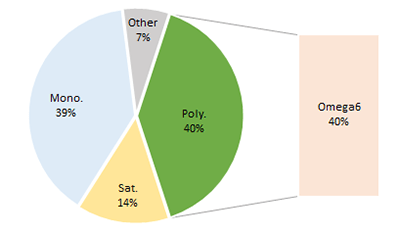 |
Smoke Point: 210oC | 410oF Predominant Fat Type: Polyunsaturated |
|
Sesame oil is used as a cooking oil and flavour enhancer in Southern India, China, Korea and other parts of Asia, and extracted from sesame seeds. Sesame oil has high levels (40%) of omega-6 fatty acid and can also be a valuable source of vitamin E. | |
Soya Bean (Soybean) Oil |
|
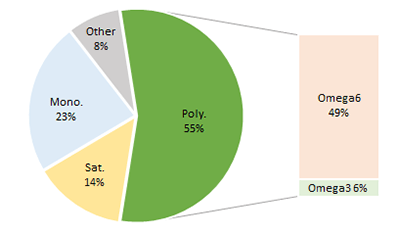 |
Smoke Point: 230oC | 450oF Predominant Fat Type: Polyunsaturated |
|
Soybean oil is extracted from the seeds of the soya bean, and accounts for around 80% of all commercial oil used in the US and around a third of all edible oil worldwide. Soybean oil is commonly hydrogenated and used in a variety of processed foods; the hydrogenated oil has much more saturated fat than the un-hydrogenated version. Soybean oil is usually used in baking and in the production of commercial, processed foods. | |
Sunflower Oil |
|
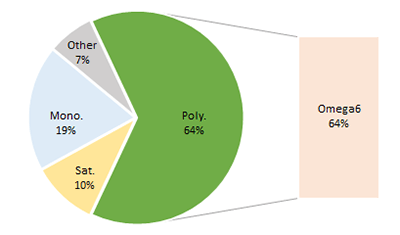 |
Smoke Point: 230oC | 450oF Predominant Fat Type: Polyunsaturated |
|
Sunflower oil is produced by pressing sunflower seeds. Sunflower oil contains a high proportion of polyunsaturated alpha-linoleic acid (Omega-6). It is versatile, with a high burn or smoke temperature and is relatively inexpensive, especially in the West. Commercially, sunflower oil has become more widely used in recent years, especially in the production of potato crisps (chips). | |
Also...
Vegetable Oil
Vegetable oil is a generic term used to describe cooking oil derived from vegetable sources. It is generally lower in saturated fats than animal-based fats and oils and is commonly used for frying food, baking and other cooking. Vegetable oil is often a blend of different types of oil, and it is therefore not possible to determine the ratio between the different types of fat. Labels on different vegetable oil products may give some clue as to the type of oils used and their relative fat contents. In the UK, rapeseed oil is often labelled as vegetable oil.
Margarine
Margarine is typically used as a substitute for butter, for spreading on bread and in baking. There are many different brands of margarine containing different blends of oils and fats. Various health claims have been made for margarine, though many of them are likely to be spurious. We do know that margarines tend to be highly processed, and you should certainly avoid buying any with ‘trans’ or hydrogenated fats as these are particularly bad for you.
Continue to:
What is Fat?
Dieting for Weight Loss

